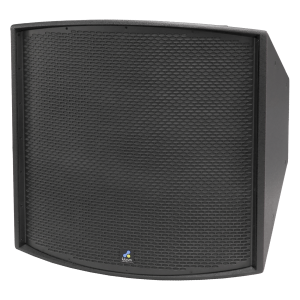Blue Cross Arena
 The Blue Cross Arena (formerly the Rochester War Memorial) has operated as a multipurpose venue for more than 60 years. It has served as the home for Rochester’s AHL hockey team, the Americans, since their founding in 1956. In addition to AHL Hockey, the arena hosts many sports and entertainment events each year.
The Blue Cross Arena (formerly the Rochester War Memorial) has operated as a multipurpose venue for more than 60 years. It has served as the home for Rochester’s AHL hockey team, the Americans, since their founding in 1956. In addition to AHL Hockey, the arena hosts many sports and entertainment events each year.
Challenges
- The relatively low roof structure limits loudspeaker mounting height. Furthermore, loudspeakers needed to be installed tight to the underside of the roof structure to avoid interfering with sightlines to the new scoreboard/display system.
- Numerous fixed rigging points used for the annual Trans-Siberian Orchestra staging (and other events) restricted the locations available for installed loudspeakers.
- Large roof trusses shadow certain seating areas from the primary loudspeakers.
Solution
 The limited trim height within the arena required a distributed loudspeaker system to achieve the project goals for audience area coverage.
The limited trim height within the arena required a distributed loudspeaker system to achieve the project goals for audience area coverage.
Fulcrum Acoustic’s AH4, AH, and FH series products were selected as the primary loudspeakers for the project. Their combination of output, fidelity, control, and efficiency is uniquely suited to the requirements of large-scale entertainment venues. They deliver extremely even response within their coverage pattern and offer the variety of horn patterns necessary to optimize coverage for the geometries of the venue’s seating. Their smooth off-axis response allows them to transition well in distributed systems where many audience members may be seated in a “seam” between adjacent loudspeaker zones.
Nine primary loudspeaker arrays provide coverage for most of the audience seats and the arena floor with supplementary delayed loudspeakers providing coverage for shadowed seats. Six of the nine arrays are flown above the dasher boards along the sides of the ice floor (three arrays per side). Each is comprised of one AH65 above one AH96, with a backwards-firing FH1596 providing coverage for the arena floor. Four arrays include 4 x CS121 cardioid subwoofers to provide low frequency support for music playback.
At the north end of the arena, three arrays provide long-throw coverage for the taller seating sections that extend upward behind the hockey goal. Each array is comprised of 1 x AH463 (long throw) above 1 x AH65 (medium throw). The center array includes 4 x CS121 cardioid subwoofers.
Supplementing the main arrays, 5 x FH1565s are mounted along the large north roof truss to cover the uppermost rows of sets that would otherwise be shadowed by the truss. On the south side of the arena, four FH1565s cover the corners and the lower-level seating. Four GX1277 12” Coaxial Loudspeakers provide coverage for a smaller, elevated seating section at the south end of the arena.
Michael Lawrence from Rational Acoustics was retained to tune and balance the system. “We had well-behaved loudspeakers, in a well-behaved design, to work with on this one,” he says. “Loudspeaker selection and system design set the bar for what’s possible during the alignment, and I could tell the Fulcrum team did a great job in that department because my team had an easy day. We worked through all 57 zones in about three hours and we were only able to move that quickly because the system was in such good shape when we showed up. I didn’t have to try to ‘band aid’ around the deployment issues I typically see. We just did some level balancing and timing and we were basically there.
 “As I was working through the system, I was walking the coverage with Stephen [Siegel, of Fulcrum Acoustic] and my tech, David Williams. We would talk about changing something by a dB here or a millisecond or two there, and when you’re talking about changes that slight, that’s how you know your system is in a good place.”
“As I was working through the system, I was walking the coverage with Stephen [Siegel, of Fulcrum Acoustic] and my tech, David Williams. We would talk about changing something by a dB here or a millisecond or two there, and when you’re talking about changes that slight, that’s how you know your system is in a good place.”
Each subwoofer array, using CS121 Passive Cardioid™ subwoofers, provides substantial low frequency output and control. “I haven’t heard low frequencies behave so well in a room that big before,” says Lawrence. “With distributed subwoofer designs, usually you have tons of late arriving energy coming at you from all over the room, and that makes a bit of a mess. But with the passive cardioid subwoofers, you shave about 10 dB off from what’s coming off the back of the box, and it’s a ‘big’ 10 dB. You end up with less energy going where you don’t want it, and perceptually it was night and day from what I would expect without that directional control in the low end. At times I had to ask the DSP tech to check the mutes because I couldn’t tell whether the subs on the other side of the arena were on.”
Project Details
| Location | Rochester, New York |
|---|---|
| Market | Sports Stadiums and Arenas |
| Type | 12,428 seat capacity arena |
| Fulcrum Products | (15) Legacy AH Series Loudspeakers |
| (3) Legacy AH4 Series Loudspeakers | |
| (15) FH15 – Full-Range Coaxial Horn | |
| (4) GX12 – 12” Coaxial Loudspeaker | |
| (20) CS121 21″ Subcardioid Subwoofer | |
| Supporting Products | QSC Q-SYS Amplifiers |






